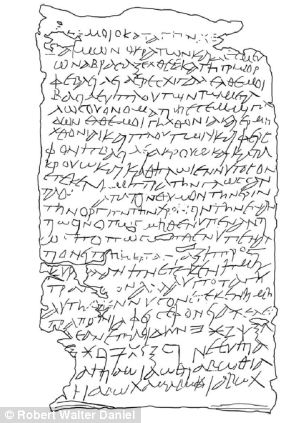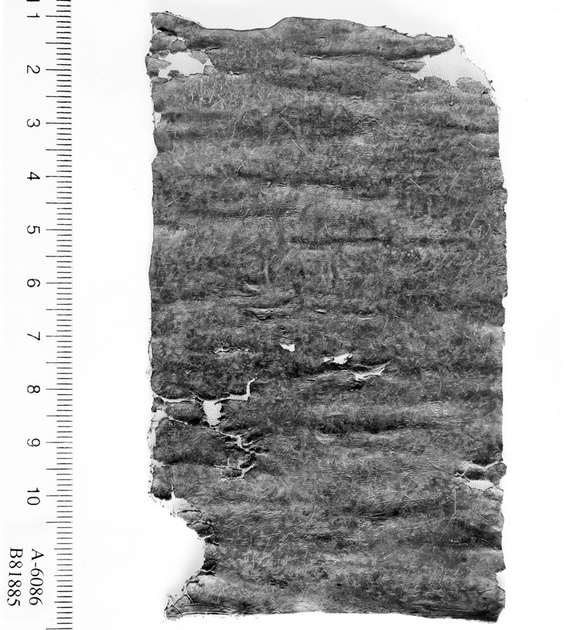
|
|||
1,700-year-old Ancient Magician's Curse Tablet in Jerusalem - Unexplained Mysteries
See more at: http://www.livescience.com/40638-ancient-curse-tablet-discovered-in-jerusalem.html
1,700 years ago, a woman named Kyrilla had vengeance on the mind. A Roman-era curse tablet discovered in a mansion in Jerusalem’s City of David invokes four religious traditions in an attempt to “strike and strike down and nail down the tongue, the eyes, the wrath, the ire, the anger, the procrastination” of the subject of the curse. The intended victim may have been opposed to Kyrilla in a legal dispute, according to a translation of the Roman curse tablet recently published in LiveScience. Made of lead and inscribed with Greek letters, the Roman curse tablet was found in a third-fourth century C.E. mansion that spreads across a half acre of the Israel Antiquities Authority (IAA) excavation beneath the Givati Parking Lot in the City of David. Kyrilla calls upon the Greco-Roman gods Hermes, Persephone, Pluto and Hecate, the Mesopotamian goddess Ereshkigal and Gnostic Abrasax amidst magical words connected with Judaism and the Hebrew language. IAA archaeologists Doron Ben Ami and Yana Tchekhanovets have also uncovered mosaic and fresco remains, carved bone fragments, female figurines and evidence of the presence of the Roman Xth legion near the Roman curse tablet. The archaeologists suggest that the curse tablet was placed in room connected with cult or in close proximity to the subject of the curse.
TRANSLATION OF THE CURSE: Come to me, you who are in the earth, chthonic daemon, you who rule and bind, Abrasax; come, Hecate, three-form queen, Ereschigal; come to me, king Pluto, by your great name Yesemmigadon; come to me, chthonic Earth and chthonic Hermes and Pluto and queen Persephone. I strike and strike down and nail down the tongue, the eyes, the wrath, the ire, the anger, the procrastination, the opposition of Iennys, whom the womb bore, so that he in no way oppose, so that he say or perform nothing adverse to Kyrilla, whom the womb bore, but rather that Iennys, whom the womb bore, be subject to her. Lady Phersephoneia, fulfi ll this perfect spell. (magical signs and letters)
She asks the gods to make sure that Iennys is 'in no way oppose, so that he say or perform nothing adverse to Kyrilla...but rather that Iennys, whom the womb bore, be subject to her'. Robert Walter Daniel, of the Institut für Altertumskunde at the University of Cologne said in a study, published in the journal Zeitschrift für Papyrologie und Epigraphi, that a professional magician probably created the curse for Kyrilla, as the small script on the tablet is rapid and fluent, suggesting practice at inscribing leaden tablets. 'While the words might be purely metaphorical, it seems more likely that Kyrilla actually used a hammer and nail(s) while carrying out a magical rite designed to enhance the efficacy of the curse,' the study said. Professor Daniel wrote: 'If she hammered and nailed several objects, they might have symbolised the seven items in the list of Iennys’ body parts and behaviours. 'If it was just a single object, then it probably symbolised the first item in that list - Iennys’ tongue - or more generally the person of Iennys. Whatever this object was, it was probably not the leaden sheet itself.' To judge from the tablet's physical condition, it was neither pounded with a hammer nor pierced with nails, but merely has the type of damage that occurs to leaden tablets while laying in the ground or during opening Horizontal creases show that the tablet was folded from the bottom to the top between eight and ten times. The archaeologists believe both Iennys and Kyrilla were probably members of the Roman middle or upper class at war with each other over a legal matter, as the curse bears some resemblance to other tablets discovered in Cyprus that were also used in legal cases. The tablet was recovered from a ruined Roman mansion and suggests that the occupants of the building were wealthy, as several gems were found at the site alongside other decorative objects including the marble bust of a boxer.  The tablet was found in the northwest part of the building, which is believed to be around 2,000 square metres, along with pieces of mosaic and fragments of frescoes as well as a decorated box full of carved bone pieces. The curse calls upon six gods (including Hermes - a statue is pictured) to help settle Kyrilla's legal score with Iennys Archaeologists told LiveScience that a female figurine - possibly that of a goddess - was also recovered by the Israel Antiquities Authority and could have been used in a private cult of people living in the huge mansion. While they are unsure of the purpose of the room, on the first floor of the house, Professor Daniel said it could have been a place where Iennys lived or worked, so the curse was close to him, or the room was near to a courtroom. The house was a large peristyle building of the Late Roman period has been unearthed on the northern part of the hill in Jerusalem known as the City of David during excavations that started in 2007 and are still continuing. Archaeological evidence suggests that the structure came to a violent end, as the latest coins found under the collapse of different rooms are from the year 363 AD, suggesting that the building was ruined as a consequence of the earthquake that occurred in Palestine on May 18 of the same year. 'No single coin retrieved from secure loci inside the building is dated later than 363 AD,' the study said. comments powered by Disqus Submit News/Videos/Links | Discuss article | Article Link More Unsolved and Unexplained Mysteries |
More can be addded on request. Direct your requests at vinit@theunexplainedmysteries.com
